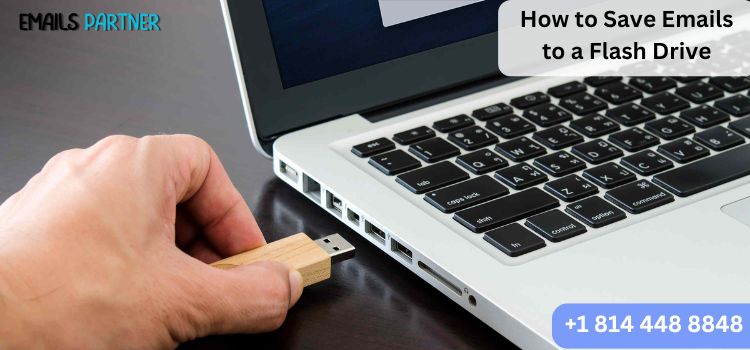Emails have become an integral part of both personal and professional communication. With an overwhelming number of emails flooding inboxes every day, it’s easy to forget how valuable this digital correspondence can be. Whether it’s for business records, personal memories, or keeping important information safe, saving emails to a flash drive efficiently is a smart way to keep your data secure and easily accessible. Flash drives are convenient, portable, and secure storage devices that allow you to store emails offline, ensuring they remain available when needed.
In this article, we’ll explore the most efficient ways to save emails to a flash drive. We will guide you through the steps, discuss different methods, and highlight tools that can streamline the process. By the end, you’ll have a better understanding of how to back up your important emails and manage them effectively using a flash drive.
Why Save Emails to a Flash Drive?
Before diving into the practical aspects of saving emails to a flash drive, it’s important to understand why this is beneficial:
- Offline Access: Saving emails to a flash drive ensures you can access them even when you’re not connected to the internet, offering an extra layer of convenience.
- Data Security: Flash drives provide a safer alternative to cloud storage. By storing emails locally on a USB flash drive, you minimize the risk of unauthorized access and potential data breaches.
- Portability: Flash drives are incredibly portable, meaning you can carry important emails with you wherever you go. This can be particularly useful if you need to share email records with others or access files on multiple devices.
- Backup: Flash drives make an excellent backup solution, protecting your emails from being lost in the event of a hard drive failure, email account issues, or accidental deletion.
- Organization: Storing emails on a flash drive allows for better organization, as you can arrange your emails into folders and categories based on your preference, making them easier to find and manage.
Methods to Save Emails to a Flash Drive Efficiently
There are several methods to save emails to a flash drive, depending on the email service you use and the format in which you prefer to store your emails. Below are the most common and efficient ways to save emails to a flash drive.
Method 1: Saving Emails from Gmail
Gmail is one of the most popular email services globally. To save emails from Gmail to a flash drive, follow these steps:
- Access Gmail on a Computer: Open your Gmail account on a desktop or laptop computer.
- Select the Emails: You can choose to save individual emails or entire threads. Click on the checkbox next to the email or thread you want to save.
- Download the Emails as PDF:
- Open the email you want to save.
- Click on the three dots (more options) in the upper-right corner of the email.
- Select “Print.”
- In the print dialog box, change the destination printer to “Save as PDF.”
- Click “Save” and select the location on your computer to save the file.
- Transfer the Files to a Flash Drive: After saving your email as a PDF, copy the file to your flash drive by simply dragging and dropping it from your computer.
- Organize the Files: You can create different folders on your flash drive to categorize the saved emails for easier access in the future.
Method 2: Saving Emails from Outlook
For Outlook users, saving emails to a flash drive can be done in a few simple steps:
- Open Outlook: Launch Outlook on your computer.
- Select the Emails: Choose the emails or threads you wish to save.
- Save as .MSG or .EML File:
- For individual emails, right-click on the email, then click on “Save As.”
- Choose the destination folder and file format (.MSG or .EML), then click “Save.”
- Copy the Files to a Flash Drive: After saving the email(s) in the desired format, copy and paste them onto your flash drive.
- Organize and Backup: You can also create folders based on email topics or recipients, making it easy to locate specific emails when you need them.
Method 3: Using Email Client Software (Thunderbird, Apple Mail, etc.)
If you use an email client like Thunderbird or Apple Mail, you can save your emails directly from the client to a flash drive.
- Set Up Your Email Client: Open your email client and configure it to sync with your email account.
- Select the Emails to Save: Choose the emails or folders you want to back up.
- Save Emails as Files:
- Right-click on the selected emails or folder.
- Choose the option to “Save As” or “Export.”
- Choose the desired file format for saving the emails (such as .EML or .MBOX).
- Transfer the Files to a Flash Drive: Once the emails are saved in the format you selected, copy them to your flash drive.
Method 4: Using Email Backup Software
There are several third-party software programs available that can help you back up emails in bulk. These programs allow you to save emails from different email providers, including Gmail, Outlook, Yahoo, and more. Some of the most popular options include:
- MailStore Home: This software allows you to archive your emails in a secure format, which you can then transfer to a flash drive. It supports multiple email services like Gmail, Outlook, and Yahoo.
- Backupify: Backupify is another tool that lets you back up emails and store them in a safe format for offline use.
- Email Backup Wizard: This software can help you download emails from various email clients and save them directly to your flash drive.
Tips for Organizing and Managing Emails on a Flash Drive
Once you’ve saved your emails to a flash drive, effective organization is key to making them easy to access later. Here are some tips:
- Create Folders by Categories: Create separate folders for different email types or categories. For example, create folders like “Work,” “Personal,” “Receipts,” or “Important Documents.”
- Name Files Appropriately: Name each saved email file with a descriptive title to make it easier to identify later. For example, use subject lines, dates, or keywords in the filenames.
- Use a Backup System: Flash drives are great for portability, but it’s important to back up your data. Consider having a second backup on an external hard drive or in the cloud.
- Use Password Protection: Since emails can contain sensitive information, consider using encryption software to password-protect the folder or files on your flash drive for additional security.
Conclusion
Saving emails to a flash drive efficiently is a smart way to ensure that important communications are securely stored and easily accessible. Whether you’re using Gmail, Outlook, or another email client, the methods outlined above provide various ways to export, save, and manage your emails on a flash drive. With the added benefits of portability and data security, using a flash drive as a backup for your emails is a reliable solution.
This post was created with our nice and easy submission form. Create your post!





